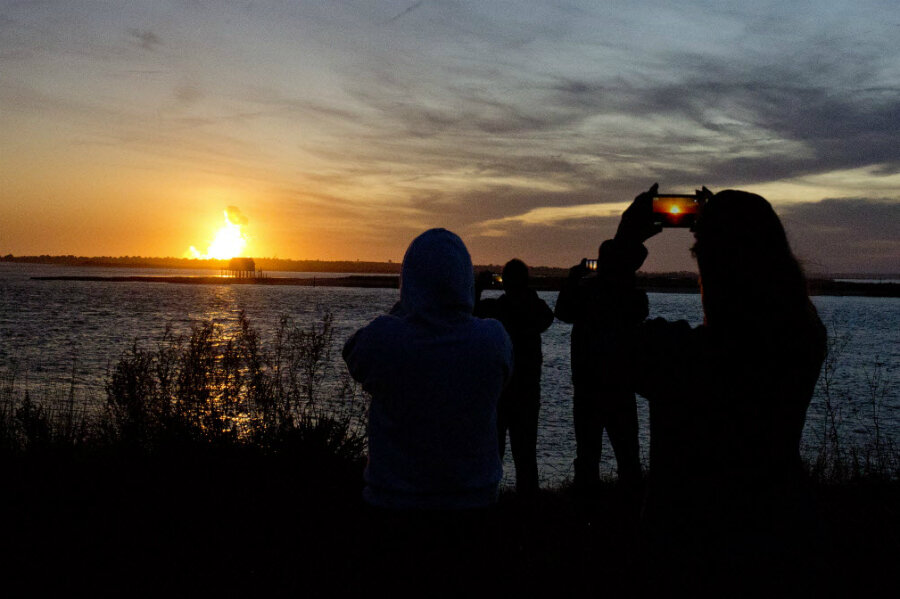Cargo rocket explosion: a setback, but not necessarily a gamechanger for NASA
Loading...
Tuesday night's explosion of a cargo rocket bound for the International Space Station seconds after launch is a setback for its owner and operator, Orbital Sciences Corp.
But the presence of a second company, Space Exploration Technologies Corp., with a different rocket, launch site, and cargo capabilities points to a more-robust resupply system for NASA than it would have had with either a single company or its own rocket, analysts say.
The loss of Orbital Science's Antares rocket and its Cygnus cargo capsule this early in a fundamental transition in the US human space-flight program grabs attention, analysts add. But it shouldn't be taken as a sign that NASA's increasing focus on using commercial carriers to deliver cargo to the station – and soon, crew members – needs to change.
Indeed, this reliance is seen as a key initial step on a long path toward a future where trips to low-Earth orbit on commercial rockets are more frequent and more affordable than today.
A launch failure is a dramatic, expensive, visceral event, acknowledges Clarissa Christensen, founder and managing partner of the Tauri Group, an aerospace and defense consulting firm in Alexandria, Va.
But one failure “does not necessarily suggest a systematic problem,” she says. Nor “is a commercial launch more or less prone to failure than a government launch.”
The loss of the rocket and its cargo is “a signal to pay attention,” she adds, rather than a signal to change direction. As a counterpoint, she notes that Russian Proton rockets – modified over the decades to become the country's workhorse for government and commercial launches – has experiences six failures since December 2010, despite a longer-term reputation as a reliable rocket.
"That's a very high number," she says.
NASA's shift to leasing services rather than owning its own rockets as part of its human-spaceflight program has been “a bold move and certainly risky in some ways – primarily because you're changing the paradigm,” says Marco Caceres, senior space analyst and director of space studies for the Teal Group Corp., an aerospace-research firm based in Fairfax., Va.
The move has been driven in no small part by an agency asked to do more than either presidents or Congress were willing to pay for, especially when thinking about eventual replacements for the space shuttles.
Tighter budgets, cost overruns, and the agency's reputation for overestimating the amount of money the space shuttles would save in operating costs because they were reusable didn't help, Mr. Caceres suggests.
With an annual budget hovering around $18 billion, NASA can't afford to do business the old way, he adds.
But it's also made possible by the presence of commercial ventures such as SpaceX, who have come to the table with the explicit interest in significantly reducing launch costs as well as carrying people into space.
The approach already is showing hints of the benefits from serving as a customer for launch services from companies that own and operate their own vehicles. One failed launch doesn't halt all resupply efforts until an investigation ends, recommendations are applied, and repairs are made to a launch facility, if needed.
Indeed, “having infrastructure in multiple places – in Virgina, Florida, and now SpaceX is building a private pad in Texas – makes a big difference” in keeping the flow of supplies moving to orbit, says Tauri's Christensen, even if the cargo is moving at a temporarily slower pace.
It's a key, if fledgling, step toward establishing a national space-transportation system.
“To create a system, you have to have a goal. The goal we're creating right now is to supply the space station and to give companies like SpaceX and Orbital experience carrying cargo, docking in space, loading, unloading – now you've got a system here,” Caceres explains.
If current plans pan out, in three or four years that will expand to a human transportation system with SpaceX and Boeing ferrying astronauts to and from the station.
This lays the foundation for companies such as Las Vegas-based Bigelow Aerospace to loft inflatable modules it has developed that either could be added to the space station or serve as the basis for on-orbit tourist destinations or as laboratories for corporate R&D.
“Step by step, you're creating a network – a system,” he says.
A national space-transportation system “is not real clear yet,” Caceres acknowledges. “Everybody's visualizing different things.”
It won't become clear, he says, until the volume of flights increases to weekly or even daily. The first step toward such regularity is likely to come through suborbital flights.
“But we're not there yet,” he says.






